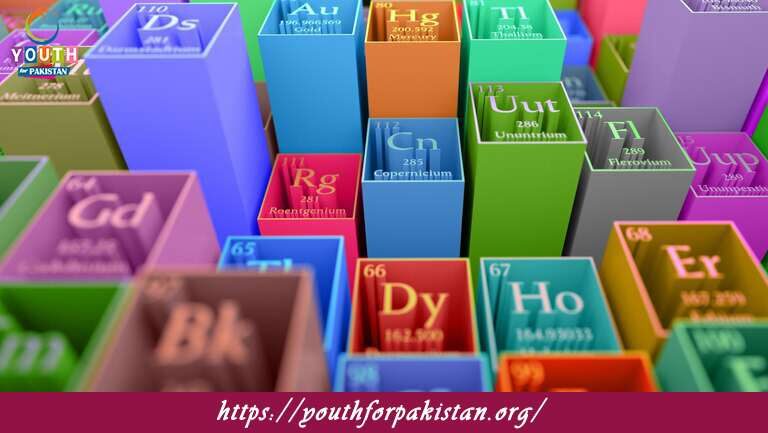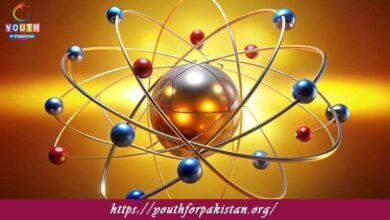9th Class Chemistry Chapter 3 MCQs with Answers

Understand the Periodic Table and Periodicity of Properties with targeted 9th Class Chemistry Chapter 3 MCQs. This resource covers group trends, periodic trends, and the classification of elements. Designed to be lucid yet effective, these MCQs come with solutions that will make your learning sound. With trending keywords such as Periodic Table Quiz and Chemical Periodicity MCQs, this post promises students working on practice for competitive exams or even in class will be interested. Raise your grasp on the periodic properties with these fun questions.
The periodic table arranges elements based on their:
a) Atomic number
b) Atomic mass
c) Number of protons
d) Number of neutrons
Elements in the same group of the periodic table have similar:
a) Atomic numbers
b) Atomic masses
c) Electron configurations
d) Number of valence electrons
The elements in the periodic table are arranged in how many periods?
a) 5
b) 6
c) 7
d) 8
Which group in the periodic table contains the alkali metals?
a) Group 1
b) Group 2
c) Group 17
d) Group 18
The element with the symbol “C” in the periodic table represents:
a) Calcium
b) Carbon
c) Copper
d) Chlorine
Elements in the same period of the periodic table have the same number of:
a) Protons
b) Neutrons
c) Electrons
d) Energy levels
Which group in the periodic table contains the halogens?
a) Group 1
b) Group 2
c) Group 17
d) Group 18
The element with the symbol “Na” in the periodic table represents:
a) Sodium
b) Nitrogen
c) Nickel
d) Neon
The element with the symbol “Fe” in the periodic table represents:
a) Fluorine
b) Iron
c) Francium
d) Phosphorus
The atomic number of an element is equal to the number of:
a) Protons
b) Neutrons
c) Electrons
d) Energy levels
Which group in the periodic table contains the noble gases?
a) Group 1
b) Group 2
c) Group 17
d) Group 18
The element with the symbol “Hg” in the periodic table represents:
a) Hydrogen
b) Helium
c) Mercury
d) Magnesium
The elements in the periodic table are arranged in how many groups?
a) 5
b) 6
c) 7
d) 8
The element with the symbol “O” in the periodic table represents:
a) Oxygen
b) Osmium
c) Oganesson
d) Phosphorus
Elements in the same group of the periodic table have the same number of:
a) Protons
b) Neutrons
c) Electrons
d) Energy levels
Which group in the periodic table contains the alkaline earth metals?
a) Group 1
b) Group 2
c) Group 17
d) Group 18
The element with the symbol “He” in the periodic table represents:
a) Helium
b) Hydrogen
c) Heliumium
d) Hafnium
The elements in the periodic table are arranged in order of increasing:
a) Atomic number
b) Atomic mass
c) Electronegativity
d) Ionization energy
The element with the symbol “Au” in the periodic table represents:
a) Aluminum
b) Arsenic
c) Gold
d) Silver
Elements in the same group of the periodic table have similar:
a) Atomic numbers
b) Atomic masses
c) Electron configurations
d) Number of valence electrons
Which group in the periodic table contains the transition metals?
a) Group 1
b) Group 2
c) Group 3 to 12
d) Group 17
The element with the symbol “K” in the periodic table represents:
a) Potassium
b) Phosphorus
c) Krypton
d) Kryptonite
Elements in the same period of the periodic table have the same number of:
a) Protons
b) Neutrons
c) Electrons
d) Energy levels
The element with the symbol “Cl” in the periodic table represents:
a) Chlorine
b) Chromium
c) Cobalt
d) Copper
The atomic number of an element is equal to the number of:
a) Protons
b) Neutrons
c) Electrons
d) Energy levels
Which group in the periodic table contains the lanthanides and actinides?
a) Group 1
b) Group 2
c) Group 3 to 12
d) Group 13 to 18
The element with the symbol “Na” in the periodic table represents:
a) Sodium
b) Nitrogen
c) Nickel
d) Neon
The element with the symbol “Ag” in the periodic table represents:
a) Argon
b) Silver
c) Silicon
d) Sodium
The elements in the periodic table are arranged in how many periods?
a) 5
b) 6
c) 7
d) 8
Which group in the periodic table contains the halogens?
a) Group 1
b) Group 2
c) Group 17
d) Group 18
The element with the symbol “Ca” in the periodic table represents:
a) Carbon
b) Calcium
c) Cesium
d) Chlorine
The atomic number of an element is equal to the number of:
a) Protons
b) Neutrons
c) Electrons
d) Energy levels
Which group in the periodic table contains the noble gases?
a) Group 1
b) Group 2
c) Group 17
d) Group 18
The element with the symbol “Mg” in the periodic table represents:
a) Magnesium
b) Manganese
c) Mercury
d) Molybdenum
The elements in the periodic table are arranged in order of increasing:
a) Atomic number
b) Atomic mass
c) Electronegativity
d) Ionization energy
Which group in the periodic table contains the transition metals?
a) Group 1
b) Group 2
c) Group 3 to 12
d) Group 17
The element with the symbol “Ar” in the periodic table represents:
a) Argon
b) Aluminum
c) Arsenic
d) Argentum
The element with the symbol “Al” in the periodic table represents:
a) Aluminum
b) Argon
c) Arsenic
d) Argentum
The elements in the periodic table are arranged in how many groups?
a) 5
b) 6
c) 7
d) 8
Which group in the periodic table contains the alkaline earth metals?
a) Group 1
b) Group 2
c) Group 17
d) Group 18
The element with the symbol “Ne” in the periodic table represents:
a) Neon
b) Nitrogen
c) Nickel
d) Sodium
Elements in the same period of the periodic table have the same number of:
a) Protons
b) Neutrons
c) Electrons
d) Energy levels
The element with the symbol “F” in the periodic table represents:
a) Fluorine
b) Francium
c) Fluoride
d) Ferrum
The element with the symbol “P” in the periodic table represents:
a) Phosphorus
b) Potassium
c) Palladium
d) Platinum
The atomic number of an element is equal to the number of:
a) Protons
b) Neutrons
c) Electrons
d) Energy levels
Which group in the periodic table contains the lanthanides and actinides?
a) Group 1
b) Group 2
c) Group 3 to 12
d) Group 13 to 18
The element with the symbol “K” in the periodic table represents:
a) Potassium
b) Phosphorus
c) Krypton
d) Kryptonite
The element with the symbol “Cl” in the periodic table represents:
a) Chlorine
b) Chromium
c) Cobalt
d) Copper
Elements in the same period of the periodic table have the same number of:
a) Protons
b) Neutrons
c) Electrons
d) Energy levels
The element with the symbol “He” in the periodic table represents:
a) Helium
b) Hydrogen
c) Heliumium
d) Hafnium
Which group in the periodic table contains the lanthanides and actinides?
a) Group 1
b) Group 2
c) Group 3 to 12
d) Group 13 to 18
The element with the symbol “Na” in the periodic table represents:
a) Sodium
b) Nitrogen
c) Nickel
d) Neon
The elements in the periodic table are arranged in how many periods?
a) 5
b) 6
c) 7
d) 8
Which group in the periodic table contains the halogens?
a) Group 1
b) Group 2
c) Group 17
d) Group 18
The element with the symbol “Ca” in the periodic table represents:
a) Carbon
b) Calcium
c) Cesium
d) Chlorine
The atomic number of an element is equal to the number of:
a) Protons
b) Neutrons
c) Electrons
d) Energy levels
Which group in the periodic table contains the noble gases?
a) Group 1
b) Group 2
c) Group 17
d) Group 18
The element with the symbol “Mg” in the periodic table represents:
a) Magnesium
b) Manganese
c) Mercury
d) Molybdenum
The elements in the periodic table are arranged in order of increasing:
a) Atomic number
b) Atomic mass
c) Electronegativity
d) Ionization energy
Which group in the periodic table contains the transition metals?
a) Group 1
b) Group 2
c) Group 3 to 12
d) Group 17
If you are interested to enhance your knowledge regarding Physics, Chemistry, Biology, and Computer please click on the link of each category, you will be redirected to dedicated website for each category.




